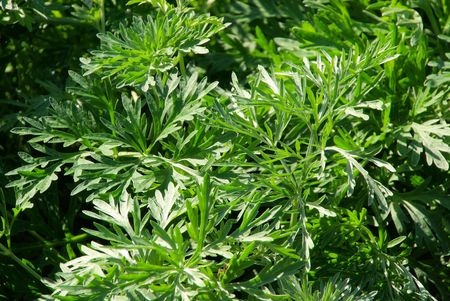Absinthe Wormwood - Artemisia absinthium

Common Names: Wormwood, absinthe, absinthium, absinthe wormwood, common wormwood, grand wormwood, green ginger, Artemisia absinthium
Latin Name: Artemisia absinthium
Origin: Asia, Australia, Europe, South America, North America
Short Introduction
Absinthe Wormwood thrives best in dry, calcareous (lime-rich) soils. It can be cultivated in full sun in moderately rich soil, high in nitrogen. Propagation is possible by using flowering cuttings in spring or autumn in temperate climates, or by sowing seeds that sprout indoors. The plant may also self-seed and spread naturally. Harvest the 20–30 cm long flowering aerial parts (Absinthii herba) during July or August. Stems are cut and bundled to dry outdoors or indoors at 40°C. The highest-quality portions are the leaves and flowers, which are known for their bitter taste.
Detailed Description
A classic ingredient in liqueurs and wines, Absinthe Wormwood is celebrated for its positive effects on digestion.
Botanical Information
Absinthe Wormwood is a perennial herb with fibrous roots. The upright stem is branched, grooved, slightly woolly, densely leafy, and the lower part becomes somewhat woody, giving the plant a silvery-green hue. It typically reaches heights of 0.5–1.2 meters (sometimes up to 1.5 meters!). The leaves are pinnately lobed, arranged spirally, silvery-green, alternate, felted, grayish-green on the upper side, and whitish underneath with fine hairs. Basal leaves are smaller, up to 10 cm long, long-stalked, three-pinnate, blunt, and less divided; upper leaves are simply or doubly pinnate. The flower heads are yellow, tubular or globular, distributed in a richly branched panicle 3–4 mm in diameter. Blooming occurs from July to October, with pollination by insects. The fruit is an egg-shaped achene, with seeds dispersed by wind.
Origin and Distribution
Absinthe Wormwood is native to temperate regions of Europe, Asia, Asia Minor, the Mediterranean, and the Middle East, and is commonly cultivated—though it often escapes and naturalizes along roadsides, embankments, wastelands, meadow and field margins, rocky slopes, and sunny, dry, neglected sites. It is also grown outside its native range, such as in North America, North Africa, and select regions of India.
Today, it is widely cultivated across nearly all of Europe, extending to the western Himalayas and southern Siberia, as well as parts of North and South America (including Brazil and Argentina’s Patagonia), and New Zealand. In the Czech Republic, it is found in many wild locations, especially in warmer steppe grasslands, on old walls, and on gravelly, sunlit, nitrogen- and calcium-rich soils.
Usage / Dosage
One of the oldest uses of Absinthe Wormwood is in making alcoholic extracts from the herb, including its use in absinthe and for flavoring other spirits and wines, such as bitter tinctures, vermouth, or pelinkovac (a drink popular among Southern and Eastern Slavs). As early as Antiquity, Pliny the Elder described wormwood as a stomachic. In the Middle Ages it was used to flavor mead, in Morocco it was brewed as tea, and modern England sometimes substituted it for hops in brewing beer. It’s also a popular culinary herb.
Today, fresh or dried young shoots and non-woody aerial parts of Absinthe Wormwood are used in cooking, on their own or with other herbs, when preparing many bitter drinks—both non-alcoholic (tonics) and alcoholic (absinthe, vermouth, etc.). As a seasoning, fresh leaves are especially used with fatty roasted or boiled meats to enhance aroma/flavor and support digestion.
In pharmacy and folk medicine, only the internal use of wormwood spirit as a bitter digestive and stomachic remedy is traditional, supporting digestion, addressing loss of appetite, gallbladder colic, stomach cramps, intestinal worms, and menstrual pain. Extracts from the herb increase secretion of stomach and bile juices and relieve spasms. It is essential to observe correct therapeutic dosing and avoid both acute and long-term overdoses, as this can lead to headaches, confusion, nausea, and other unpleasant symptoms.
The active compounds in Absinthe Wormwood stimulate gastric juice production, are mildly antiseptic, and have a positive effect on gallbladder and liver function. In the proper concentration, the herb supports appetite, prevents vomiting, relieves diarrhea, and assists in gallbladder issues. Its bitter principles and essential oils improve digestion, increase appetite, and alleviate cramps by blocking nerve impulses at the neuromuscular junction. Absinthe Wormwood is also gently antiseptic and relieves cramps. It may be used in cases of gastritis with low stomach acidity. Some folk practitioners recommend wormwood for flu, colds, insomnia, rheumatism, and eczema.
Active Compounds
The aerial parts of Absinthe Wormwood contain essential oils (0.2–0.5%), primarily thujone, chamazulene, and thujol. Other major constituents include sesquiterpene lactones, various bitter principles such as candenene and phellandrene, glycosidic bitter substances like absinthin and anabsinthin, along with tannins, resins, organic acids, flavonoids like quercetin and artemisetin, among others.
Traditional Dosage
Proper dosing is vital! The maximum single oral dose should not exceed one gram of dried herb; the daily maximum should not exceed three grams. A minor portion of the active substances will dissolve in water, but more are extracted with alcohol (in liqueur or wine)—in these cases, dosage should be reduced accordingly. The top-quality tea is prepared from fresh aerial parts. Tincture or tea should ideally be taken at least 30 minutes before meals.
